

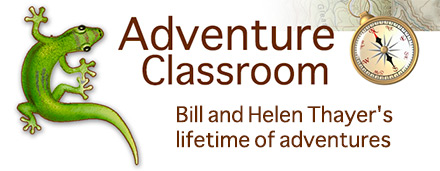
JOSHUA TREE NATIONAL PARK
photos (c) Helen Thayer
I chose Joshua Tree National Park as the second Park in the Adventure Classroom National Park series because it's very different from Death Valley National Park. Joshua Tree National Park is located in Southern California, a two-day drive from my home in Washington State.
Learn More About Joshua Tree [Page Two]
 Campsite - photo Thea Nutter
Campsite - photo Thea Nutter
I arrived at the Park in April, 2019. With my friend Thea, we set up a base camp at a spectacular campground called Indian Cove situated close to the northern boundary of the Park amidst an area aptly named the Wonderland of Rocks. As we entered the area the sight of so many towering rock piles piled at odd angles often one on top of another was almost overwhelming. However rain clouds were threatening so camp was set up in a hurry. But rain clouds or not, the urge to explore the area was irresistible. Photographic opportunities were everywhere.
The bright magenta colored flowers of the beaver tail cactus were in full bloom. An orange globemallow plant bravely growing in a rocky crevasse was a contrast in color. Carefully, watching out for rattlesnakes, I ventured into a rocky basin. One thing I had to be very careful of this spring was the rattlesnakes. This is an area where the Mojave rattlesnake lives. It is considered to be the most venomous rattlesnake in the world. There was a lot of evidence of snakes. Park employees had warned us when we entered the Park on the first day and I could tell that this year there were more snakes than usual.
Joshua Tree is unique in that it straddles two desert systems. The northern half consists of the Mojave Desert at about 3,000 feet and above, while the southern half consists of the Colorado Desert at a much lower altitude.
 Typical Joshua Trees
Typical Joshua Trees
I was really lucky to be exploring the Park during a "Super Bloom." It was spectacular. A "super bloom" occurs after heavy rains fall in winter and early spring. When spring arrives the flowers burst forth in an explosion of color and variety. It is an amazing sight. Flowers were everywhere. The crimson claret cup and beaver tail cactus dotted the landscape with their eye-catching colors. Other flowers such as globemallow, evening primrose and the majestic Mojave yucca were in full bloom. The mature yucca can be three or four feet high with tall clusters of creamy colored flowers. The yucca, one of my favorite flowers, was in full bloom giving me many opportunities for that special photo. At first the urge to photograph everything in sight soon faded when I discovered that the Park was one giant photographic opportunity.
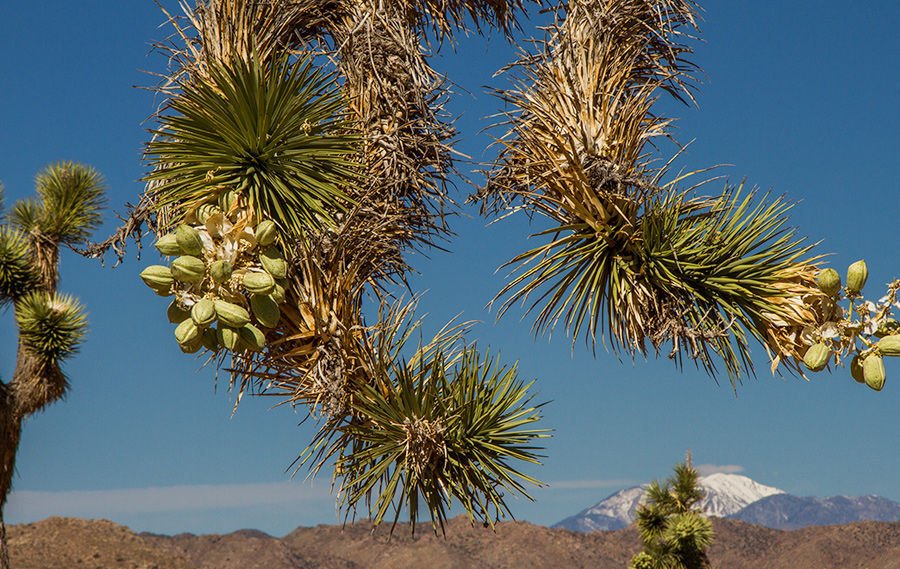 Branches up close with seed pods
Branches up close with seed pods
Around noon we stopped for the usual peanut butter and jelly sandwich. The temperature was in the 80's and it felt good to find shade during the hot noon hours. In the afternoon we explored the rocky areas. It was odd to see giant rocks some as big as cars, sitting on top of each other as if a machine had picked them up and carefully placed them there. Of course Sam, my canine hiking partner was with me, and I was particularly careful in not allowing him to satisfy his curiosity and investigate any signs of snakes. Even though he was always on a 6-foot leash I kept a sharp eye on where he placed his paws.
Because Joshua trees, the iconic plant of the Park, likes the higher altitude of the Mojave Desert that was where we found most of them. I always wanted that special photo of the flower and I wasn't disappointed. They were in full bloom with white clusters of flowers on the ends of each branch. After the flowers die they leave large, green, hard shelled seedpods.
The trees are a strange sight. No two trees are alike. The branches look more like arms reaching out in all directions. All too soon the light faded toward evening and we returned to camp and a dinner of canned meat and vegetables.

Helen and Sam - photo Thea Nutter
Next day was another perfect sunny day, although it proved to be warmer than the previous day, as the temperature climbed into the high 80's by noon. I wanted to explore some of the well-known features and rock formations. We set off to find Scull Rock. There it was, looking just like an enormous human scull. But that wasn't the only peculiar looking rock. Another looked like an amphitheater with it's hollowed out center. Another group reminded me of ancient Egyptian figures standing silently observing the several other tourists busy taking photos. Everywhere we went there was a rock formation or a Joshua tree or some flowers that caught our eye.
We found an area of evening primrose. It's a white fading to pink fairly large flower and appeared to grow in the sandy areas. We also found many clumps of bright red claret cup cactus also known as Mojave mound cactus tucked away among the rocks. Its clusters of flowers were so perfectly formed they almost looked artificial. Desert dandelion grew in carpets of bright yellow daisies that spread low to the ground and were absolutely dazzling. After another exciting day of exploring rocks and plants, and note taking for Adventure Classroom, we returned to camp for a night's rest.
Next day I decided to explore the Geology Tour road in my 4-wheel drive jeep. The unmaintained track was deep sand in places but the Jeep was up to the task. The route descended 1,000 feet and took us south across an ancient dried up lakebed. There were rock out crops here and there and there was a noticeable lack of Joshua trees and other plant life found in the northern Mojave. We passed through carpets of low growing flowers. Vegetation was sparse and grew lower to the ground.
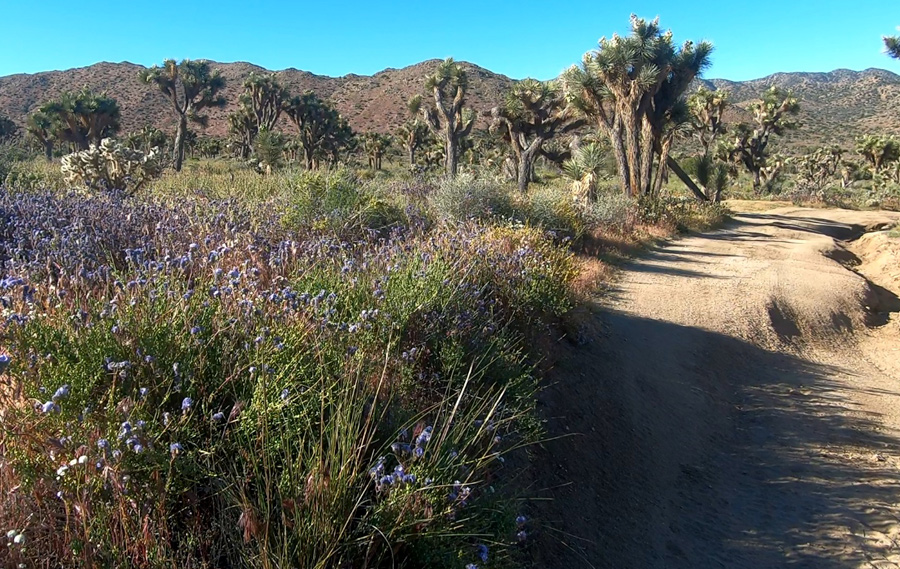
Typical back road
We found one large Joshua tree. When I got too close to its sharp pointed leaves I quickly discovered that the point on the end of each leaf can draw blood; it is best given some distance.
The following day, while enduring increasing temperatures, we explored the Pinto basin, an enormous 200-square-mile area in the southern area of the Park's Colorado Desert. It was a steep contrast to the Mojave in the north. It is a wide flat plain and has no streams and only low growing plants, and even in this year of the "super bloom" it had few flowers.
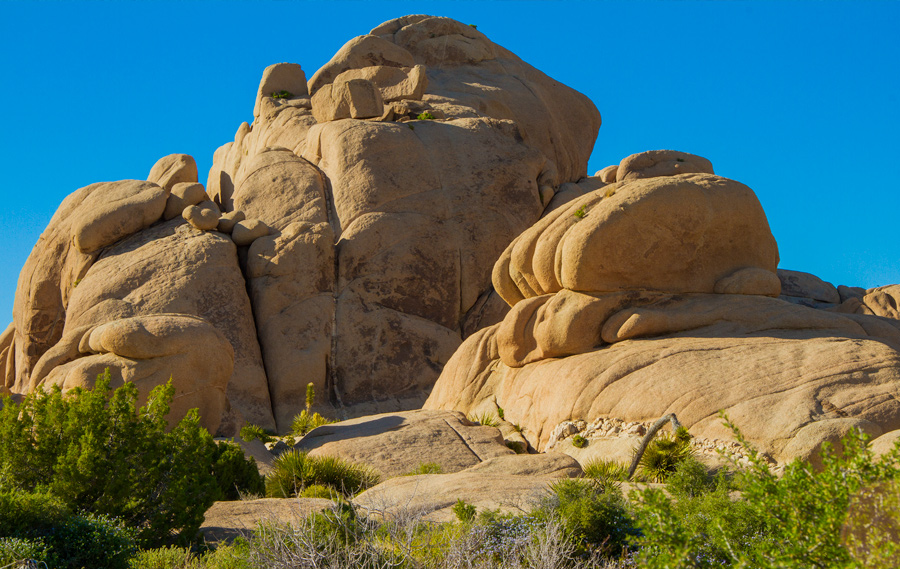
Rocks and more rocks
Our last day was spent exploring the western area where we found some of the largest and oldest Joshua trees. Because the area sits at a higher elevation, the flowers were at their peak a little later than those at the lower elevation. The Joshua trees were breathtaking. The yucca plants were magnificent. I was in photography heaven. However snakes were also prevalent. We saw even more evidence that there were many in the area. I kept Sam a little closer for safety.
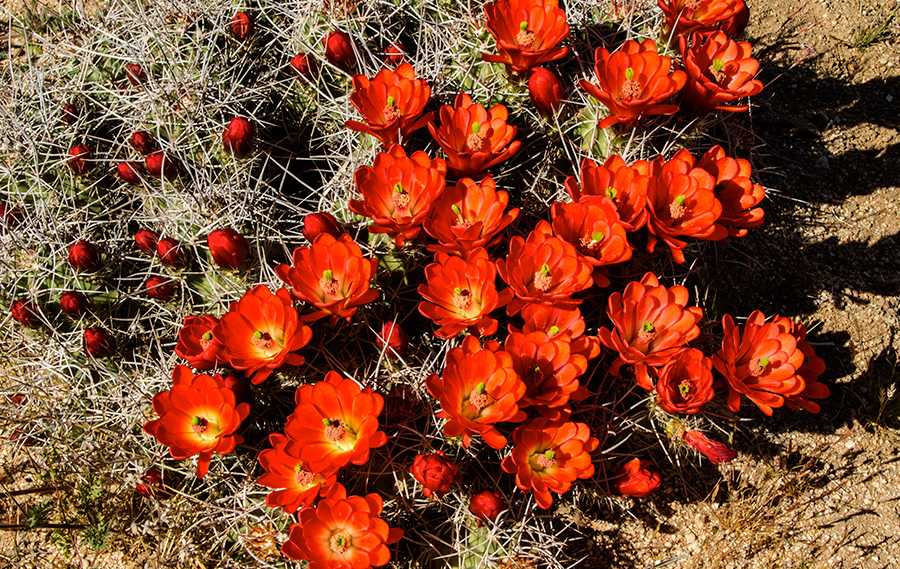
Vibrant Claret Cup Cactus
In this area we saw ample evidence of forest fires from past seasons. Many Joshua trees were burnt and laying at grotesque angles as if in protest. A roadrunner bird dashed through the undergrowth. His speed was impressive.
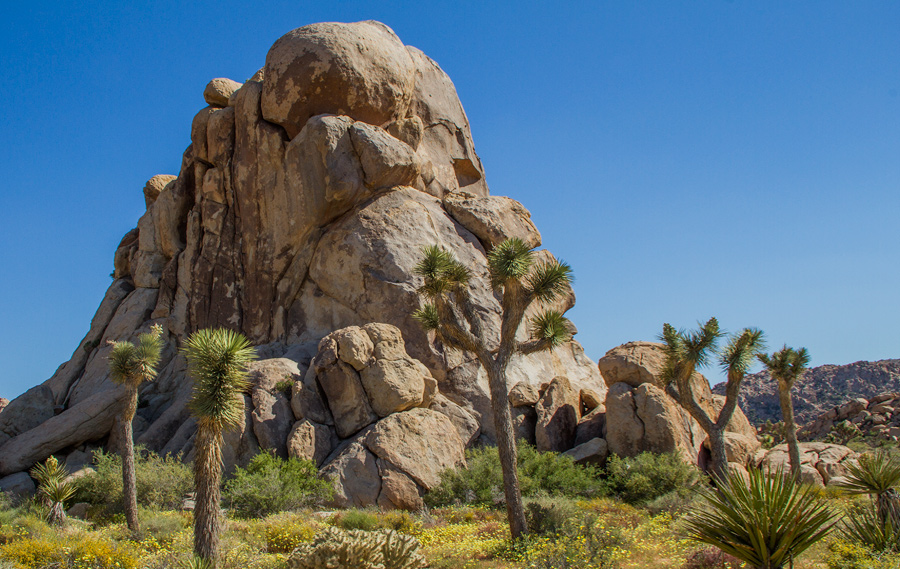
Young trees and old rocks
The temperature reached 96 degrees on our last day, but the beauty of the Park remained absolutely outstanding. It was an amazing experience to be there. The colorful variety of flowers against the backdrop of the dramatic and unusual rocks of the Park was a glorious sight.
The distinct contrast between the two desert systems that the Park encompasses provides an unusual opportunity to see two deserts in one visit. It is a Park where families can enjoy time together, and a place to learn more about desert environs. Although Joshua Tree National Park is surrounded by a high-density population, it is a clear example of the excellent job the National Park Service and its employees do to keep this special place wild and pristine.
Learn More About Joshua Tree [Page Two]
Back to [National Parks Index]
